
Aztec mythology is the body or collection of myths of Aztec civilization of Central Mexico. The Aztecs were Nahuatl-speaking groups living in central Mexico and much of their mythology is similar to that of other Mesoamerican cultures. According to legend, the various groups who were to become the Aztecs arrived from the north into the Anahuac valley around Lake Texcoco. The location of this valley and lake of destination is clear – it is the heart of modern Mexico City – but little can be known with certainty about the origin of the Aztec. There are different accounts of their origin. In the myth the ancestors of the Mexica/Aztec came from a place in the north called Aztlan, the last of seven nahuatlacas to make the journey southward, hence their name "Azteca." Other accounts cite their origin in Chicomoztoc, "the place of the seven caves," or at Tamoanchan.
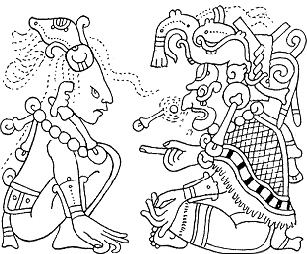
Maya mythology is part of Mesoamerican mythology and comprises all of the Maya tales in which personified forces of nature, deities, and the heroes interacting with these play the main roles. The myths of the Pre-Hispanic era have to be reconstructed from iconography. Other parts of Maya oral tradition are not considered here.

In Aztec mythology, Xolotl was the god with associations to both lightning and death. He was associated with the sunset and would guard the Sun as it traveled through the underworld every night. Dogs were associated with Xolotl. This deity and a dog were believed to lead the soul on its journey to the underworld. He was commonly depicted as a monstrous dog. Xolotl was the god of fire and lightning. He was also god of twins, monsters, misfortune, sickness, and deformities. Xolotl is the canine brother and twin of Quetzalcoatl, the pair being sons of the virgin Coatlicue. He is the dark personification of Venus, the evening star, and was associated with heavenly fire.
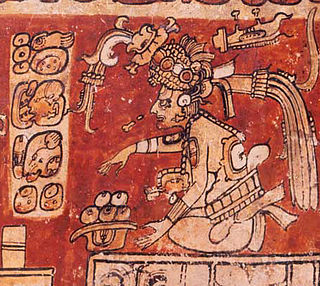
Itzamna was, in Maya mythology, the name of an upper god and creator deity thought to reside in the sky. Although little is known about him, scattered references are present in early-colonial Spanish reports (relaciones) and dictionaries. Twentieth-century Lacandon lore includes tales about a creator god who may be a late successor to him. In the pre-Spanish period, Itzamna, represented by the aged god D, was often depicted in books and in ceramic scenes derived from them.

The Mesoamerican ballgame was a sport with ritual associations played since 1400 BC by the pre-Columbian people of Ancient Mesoamerica. The sport had different versions in different places during the millennia, and a newer more modern version of the game, ulama, is still played in a few places by the indigenous population.
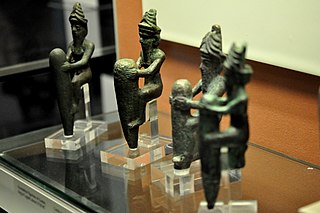
The Anunnaki are a group of deities that appear in the mythological traditions of the ancient Sumerians, Akkadians, Assyrians, and Babylonians. Descriptions of how many Anunnaki there were and what role they fulfilled are inconsistent and often contradictory. In the earliest Sumerian writings about them, which come from the Post-Akkadian period, the Anunnaki are the most powerful deities in the pantheon, descendants of An and Ki, the god of the heavens and the goddess of earth, and their primary function is to decree the fates of humanity.

In pre-Columbian Maya civilization, ceremonial dance had great importance. However, since dance is a transient art, it is inherently difficult for archeologists to find and evaluate evidence of its role. There is little material information left behind, beyond a few paintings on murals and vases. This lack of direct evidence leads to several different archaeological interpretations.
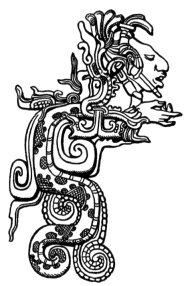
The Vision Serpent is an important creature in Pre-Columbian Maya mythology, although the term itself is now slowly becoming outdated.
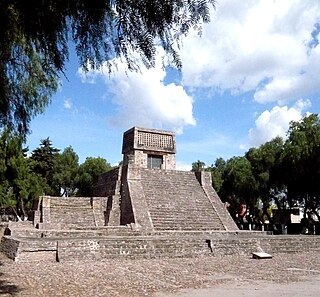
The Aztec religion originated from the indigenous Aztecs in central Mexico. Like other Mesoamerican religions, it had elements of human sacrifice in connection with a large number of religious festivals on the Aztec calendar. The polytheistic religion recognized a large and ever increasing pantheon of gods and goddesses; the Aztecs would often incorporate deities whose cults came from other geographic regions or peoples into their own religious practice.
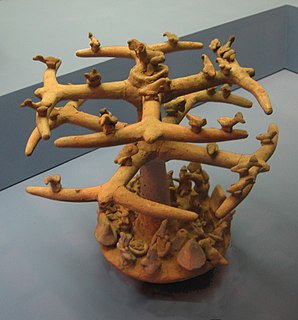
World trees are a prevalent motif occurring in the mythical cosmologies, creation accounts, and iconographies of the pre-Columbian cultures of Mesoamerica. In the Mesoamerican context, world trees embodied the four cardinal directions, which also serve to represent the fourfold nature of a central world tree, a symbolic axis mundi which connects the planes of the Underworld and the sky with that of the terrestrial realm.

The traditional Maya religion of Guatemala, Belize, western Honduras, and the Tabasco, Chiapas, and Yucatán regions of Mexico is a southeastern variant of Mesoamerican religion. As is the case with many other contemporary Mesoamerican religions, it results from centuries of symbiosis with Roman Catholicism. When its pre-Spanish antecedents are taken into account, however, traditional Maya religion already exists for more than two millennia as a recognizably distinct phenomenon. Before the advent of Christianity, it was spread over many indigenous kingdoms, all with their own local traditions. Today, it coexists and interacts with pan-Mayan syncretism, the 're-invention of tradition' by the Pan-Maya movement, and Christianity in its various denominations.

Death rituals were an important part of Maya religion. The Maya greatly respected death; they were taught to fear it and grieved deeply for the dead. They also believed that certain deaths were more noble than others.

Ancient Egyptian deities are the gods and goddesses worshipped in ancient Egypt. The beliefs and rituals surrounding these gods formed the core of ancient Egyptian religion, which emerged sometime in prehistory. Deities represented natural forces and phenomena, and the Egyptians supported and appeased them through offerings and rituals so that these forces would continue to function according to maat, or divine order. After the founding of the Egyptian state around 3100 BC, the authority to perform these tasks was controlled by the pharaoh, who claimed to be the gods' representative and managed the temples where the rituals were carried out.

In Mesoamerican culture, Tonatiuh was as an Aztec sun deity of the day sky and ruled the cardinal direction of east. According to Aztec Mythology, Tonatiuh was known as "The Fifth Sun" and was given a calendar name of naui olin, which means "4 Movement". Represented as a fierce and warlike god, he is first seen in Early Postclassic art of the Pre-Columbian civilisation known as the Toltec. Tonatiuh's symbolic association with the eagle alludes to the Aztec belief of his journey as the present sun, travelling across the sky each day, where he descended in the west and ascended in the east. It was thought that his journey was sustained by the daily sacrifice of humans. His Nahuatl name can also be translated to "He Who Goes Forth Shining" or "He Who Makes The Day." Tonatiuh was thought to be the central deity on the Aztec Calendar Stone but is no longer identified as such. In Toltec culture, Tonatiuh is often associated with Quetzalcoatl in his manifestation as the morning star aspect of the planet Venus.

Sumerian religion was the religion practiced and adhered to by the people of Sumer, the first literate civilization of ancient Mesopotamia. The Sumerians regarded their divinities as responsible for all matters pertaining to the natural and social orders.

The Maya death gods, known by various names, are two basic types of death gods who are respectively represented by the 16th-century Yucatec deities Hunhau and Uacmitun Ahau mentioned by Spanish Bishop Landa. Hunhau is the lord of the Underworld. Iconographically, Hunhau and Uacmitun Ahau correspond to the Gods A and B'.

A deity is a supernatural being considered divine or sacred. The Oxford Dictionary of English defines deity as "a god or goddess ", or anything revered as divine. C. Scott Littleton defines a deity as "a being with powers greater than those of ordinary humans, but who interacts with humans, positively or negatively, in ways that carry humans to new levels of consciousness, beyond the grounded preoccupations of ordinary life". In the English language, a male deity is referred to as a god, while a female deity is referred to as a goddess.

The Classic Maya used dedication rituals to sanctify their living spaces and family members by associating their physical world with supernatural concepts through religious practice. The existence of such rituals is inferred from the frequent occurrence of so-called 'dedication' or 'votive' cache deposits in an archaeological context.

The ancient Mesopotamian underworld, most often known in Sumerian as Kur, Irkalla, Kukku, Arali, or Kigal and in Akkadian as Erṣetu, although it had many names in both languages, was a dark, dreary cavern located deep below the ground, where inhabitants were believed to continue "a shadowy version of life on earth". The only food or drink was dry dust, but family members of the deceased would pour libations for them to drink. Unlike many other afterlives of the ancient world, in the Sumerian underworld, there was no final judgement of the deceased and the dead were neither punished nor rewarded for their sex in life. A person's quality of existence in the underworld was determined by his or her conditions of burial.


















